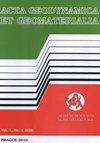Nonlinear site response analysis by coupling scaled boundary finite element method and finite element method
IF 0.8
4区 地球科学
Q4 GEOCHEMISTRY & GEOPHYSICS
引用次数: 0
Abstract
This paper presented 2D numerical linear and nonlinear site response analyses based on the scaled boundary finite-element method (SBFEM) and compared their results with those of the DEEPSOIL software. In linear time-domain analysis, the seismic boundary traction was applied to lines in the near-field with the same vertical coordinates using seismic time history load. The far-field was modeled utilizing an improved continued-fraction-based high-order transmitting boundary. The constitutive relationship of the boundary was determined utilizing the SBFEM equation in the dynamic stiffness model. It was shown that the results of the SBFEM had a good agreement with those obtained from the DEEPSOIL software. The results of spectral acceleration demonstrated period lengthening. The nonlinear site responses were analyzed using both the DEEPSOIL software and the coupling of SBFEM/FEM. The one-dimensional nonlinear site response was analyzed using the tools in the DEEPSOIL software including the strength correction, pressure-dependent modulus reduction, and the damping ratio curve of sand. In the nonlinear-coupled analysis, the bounded domain was also modeled in OpenSees using a pressuredependent multi-yield plasticity soil model. The comparison of the results demonstrated the accuracy of the nonlinear analysis using the coupled SBFEM/FEM. The coupling method underestimated spectral acceleration in low periods compared with the DEEPSOIL software. The absolute residual was also obtained less than 0.2. ARTICLE INFO Article history: Received 25 May 2020 Accepted 31 August 2020 Available online 19 September 2020非线性场地响应的尺度边界有限元法与有限元法耦合分析
本文提出了基于比例边界有限元法(SBFEM)的二维数值线性和非线性场地响应分析,并与DEEPSOIL软件的结果进行了比较。在线性时域分析中,利用地震时程荷载对具有相同纵坐标的近场线进行地震边界牵引。利用改进的基于连续分数的高阶传输边界对远场进行建模。利用动刚度模型中的SBFEM方程确定了边界的本构关系。结果表明,SBFEM计算结果与DEEPSOIL软件计算结果吻合较好。光谱加速结果显示周期延长。采用DEEPSOIL软件和SBFEM/FEM耦合方法对非线性场地响应进行了分析。利用DEEPSOIL软件中的强度修正、压力相关模量折减和砂土阻尼比曲线等工具,分析了一维非线性场地响应。在非线性耦合分析中,在OpenSees中使用压力相关的多屈服塑性土壤模型对有界域进行建模。计算结果的对比表明,采用SBFEM/FEM耦合方法进行非线性分析是准确的。与DEEPSOIL软件相比,耦合方法低估了低周期谱加速度。残差绝对值也小于0.2。文章信息文章历史:2020年5月25日收稿2020年8月31日接收2020年9月19日在线发布
本文章由计算机程序翻译,如有差异,请以英文原文为准。
求助全文
约1分钟内获得全文
求助全文
来源期刊

Acta Geodynamica et Geomaterialia
地学-地球化学与地球物理
CiteScore
2.30
自引率
0.00%
发文量
12
期刊介绍:
Acta geodynamica et geomaterialia (AGG) has been published by the Institute of Rock Structures and Mechanics, Czech Academy of Sciences since 2004, formerly known as Acta Montana published from the beginning of sixties till 2003. Approximately 40 articles per year in four issues are published, covering observations related to central Europe and new theoretical developments and interpretations in these disciplines. It is possible to publish occasionally research articles from other regions of the world, only if they present substantial advance in methodological or theoretical development with worldwide impact. The Board of Editors is international in representation.
 求助内容:
求助内容: 应助结果提醒方式:
应助结果提醒方式:


